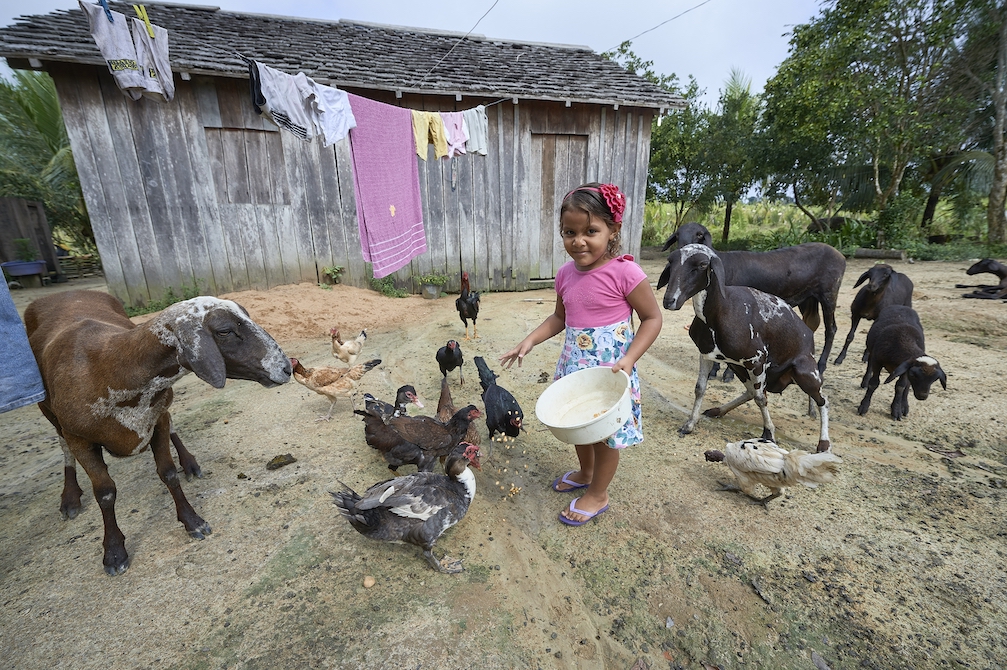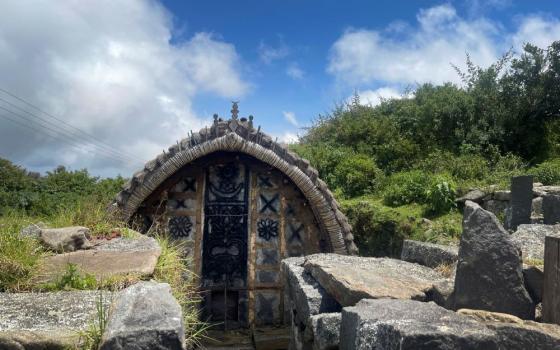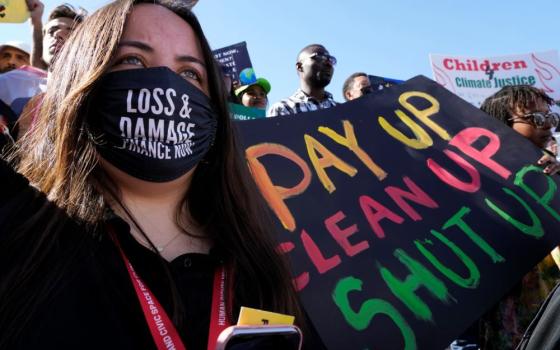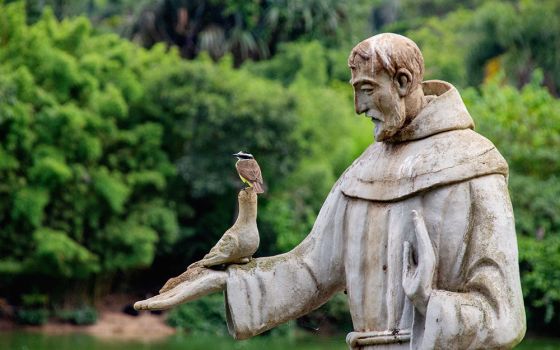
(Unsplash/Joshua J. Cotten)
Welcome to Burning Questions, the EarthBeat feature that takes on those questions smoldering in your mind about climate change and religion — from the basics to more complex, and everything in between. Have a Burning Question of your own? Let us know.
This story has been updated to include additional events, programs and resources for the 2020 Season of Creation.
August is almost over. September is nearly here. And for more and more Christians, that change of months also signals the arrival of the Season of Creation.
What's that, you may be asking?
Rest assured, this week's Burning Question has all the answers and background on a church season that's becoming more prominent for more Christians each year, and increasingly that includes Catholics.
What is the Season of Creation?
The Season of Creation is a monthlong prayerful observance that calls the planet's 2.2 billion Christians to pray and care for God's creation. It's a time to reflect on our relationship with the environment — not just "distant" nature, but, crucially, the place where we live — and the ways in which our lifestyles and decisions as a society can endanger both the natural world and those inhabiting it, both humans and other creatures.
The ecumenical steering committee that plans and promotes the season each year put it this way:
The Season of Creation is a time to renew our relationship with our Creator and all creation through celebration, conversion, and commitment together. During the Season of Creation, we join our sisters and brothers in the ecumenical family in prayer and action for our common home.
It's a time of prayer, contemplation and, increasingly, calls to action. (More on that later.)
The Season of Creation is supported by a number of leading Christian organizations, including the World Council of Churches, Christian Aid, the Lutheran World Federation, the Anglican Communion Environmental Network, the Global Catholic Climate Movement and the Vatican's Dicastery for the Promotion of Integral Human Development. Each sits on the Season of Creation steering committee.
Advertisement
Ok, well, when is this season?
The Season of Creation spans 34 days.
It begins Sept. 1, the World Day of Prayer for the Care of Creation. It concludes Oct. 4, the feast of St. Francis of Assisi, the patron saint of ecology.
As it happens, the season aligns with the fall harvest season — a time when the state of the Earth might be front of mind for many people.
People explore a trail at Cunningham Falls State Park in Thurmont, Maryland, June 17. (CNS/Tyler Orsburn)
How long has this Season been happening?
Orthodox Christians have been marking the Season of Creation for decades. It started in 1989, when Ecumenical Patriarch Dimitrios I proclaimed Sept. 1 a day of prayer for the environment. That day actually marks the beginning of the Eastern Orthodox church year.
Around that time, focus on the environment was ratcheting up worldwide. Two years earlier, the World Commission on Environment and Development released its Our Common Future report, from which developed the Earth Charter — a declaration outlining the ethical principles for sustainable development throughout the world. The charter was a central focus of the 1992 Earth Summit in Rio de Janeiro, which formed the United Nations Framework Convention on Climate Change. In 2015, negotiations stemming from this process produced the Paris Agreement, which charts a global plan to limit the planet's rising temperatures.
Over time, the single day of prayer expanded to a full season, with the World Council of Churches playing a leading role. One of the first organized celebrations of the season was held in 2000 at a Lutheran church in Adelaide, Australia. In 2003, the Catholic Church in the Philippines began asking Catholics to observe Creation Time.
More recently, the Season of Creation has become a more ecumenical celebration among all Christians. And the past few years have seen it gain traction among Catholics. For that, you can point to Pope Francis.
Just months after publishing his 2015 encyclical "Laudato Si', on Care for Our Common Home," Pope Francis formally added the World Day of Prayer for the Care of Creation to the Catholic calendar as an annual day of prayer. And last year, he officially invited Catholics to celebrate the full season.
"Now is the time to rediscover our vocation as children of God, brothers and sisters, and stewards of creation. Now is the time to repent, to be converted and to return to our roots," he wrote in a letter. "We are beloved creatures of God, who in his goodness calls us to love life and live it in communion with the rest of creation. For this reason, I strongly encourage the faithful to pray in these days that, as the result of a timely ecumenical initiative, are being celebrated as a Season of Creation."
So is it just a time for prayer?
Prayer is certainly a central part of it.
In recent years, ecumenical organizers have suggested themes as a way to unify celebrations across communities and call attention to ecological challenges facing the world. Last year, for instance, the Season of Creation put the spotlight on biodiversity, at a time when scientists predicted "unprecedented" extinction rates that could wipe out up to 1 million species in the coming decades.
This year, organizers suggested the theme, "Jubilee for the Earth: New Rhythms, New Hope." Jubilee, in biblical terms, refers to a period of restoration every 50 years, when the land rests and justice is restored. The theme is, in part, a nod to the 50th celebration of Earth Day, which occurred in April. That the global coronavirus pandemic came as the planet nears climate tipping points shows how social, economic and ecological realities are interconnected, the Season of Creation steering committee said in explaining the theme.
"During the season this year, we enter a time of restoration and hope, a jubilee for our Earth, that requires radically new ways of living with creation," the committee said, including "the need for just and sustainable systems" to take better care of both people and planet.
The Vatican's integral human development department highlighted the theme earlier this year in announcing a special yearlong celebration for the fifth anniversary of Laudato Si'. It expressed hope that the coming decade might become a " 'Jubilee' time for the Earth," lining up with the timeframe scientists say is critical to nearly halve global greenhouse gas emissions and put the planet on course to limit average temperature rise to 1.5 degrees Celsius.
How do people observe the Season of Creation?
Countless examples abound.
Special prayer services and liturgies that reflect on the sacredness of creation are common.
Some, like observers of the season in Atlanta, celebrate Green Masses. Like Red Masses (for legal professionals) and Blue Masses (for public safety), Green Masses honor those working on environmental protection and sustainability while calling all to stewardship of creation.
The Irish bishops produced a series of podcasts, covering the theology of creation care along with the science of climate change and what they can do as parishes. And the U.S. Conference of Catholic Bishops created a bulletin insert with information and prayers for the season.
Some hold traditional celebrations of the Feast of St. Francis, including a blessing of animals. The Catholic Climate Covenant produces annual programs for the Assisi feast day that can be used throughout the season.
And some Catholics have used the Season of Creation as a time to commit to living out Laudato Si'.
Many have taken to planting trees, as in the Indianapolis Archdiocese, Lancaster, England, the Philippine capital of Manila and Papua New Guinea. In 2015, the Philippine church used the season as a time to gather signatures for a Catholic Climate Petition delivered later that year to world leaders at the U.N. climate summit in Paris. The Chicago Archdiocese has urged Catholics to advocate for federal environmental legislation.
Some Catholic groups have used the time to publicly declare their commitment to financially divest from fossil fuels, as the Assisi Diocese in Italy and 30-plus other institutions did in 2017. And last year, the youth-led Laudato Si' Generation and other Catholics joined the climate strikes that took place around the globe.
At the Vatican, Francis used his 2016 message for the World Day of Prayer for the Care of Creation to suggest Christians add "care for our common home" to both the corporal and spiritual works of mercy. The next year, he and Ecumenical Patriarch Bartholomew issued a joint message urging political and business leaders to respond to pleas for "healing of our wounded creation." And in 2019, the pope participated in a tree planting in the Vatican Gardens ahead of the Amazon synod.
Children plant trees on the feast of St. Francis in October 2019 in Indianapolis. (CNS/Archdiocese of Indianapolis Creation Care Commission)
What are people doing this year?
In few words, a lot.
The Vatican's integral human development department made the Season of Creation a focal point for the Laudato Si' anniversary year, and it has encouraged bishops and ecclesial bodies to raise awareness of the season, "helping the faithful to realize that 'living our vocation to be protectors of God’s handiwork is essential to a life of virtue; it is not an optional or a secondary aspect of our Christian experience' (Laudato Si' 217)."
The Season of Creation website lists events scheduled around the globe. As is the norm these days, there will be webinars. First up is an online prayer service. Other webinars will examine what a just transition looks like in different parts of the world and ethical investment in Africa. A retreat on Laudato Si' is set for Sept. 12, to be followed by a Laudato Si' global prayer service on Oct. 2.
For those still pondering their plans, the Season of Creation website houses resources for various denominations — Anglican, Catholic, Lutheran, Orthodox and Reformed — as well as for ecumenical and interfaith programs. It has also produced an extensive celebration guide, and promotional flyers and social media posts.
Jesuit Fr. James Hug has compiled a Season of Creation liturgical guide that provides Catholic parishes with prayers and suggested songs for each Sunday. It includes background information to place the season in the context of the multitude of crises facing the world today. Similarly, the Congregation Sisters of St. Joseph has made daily reflections available.
For the Season of Creation, the Sisters of Mercy are turning their yearlong Mercy Earth Challenge to focus on food and the way food systems are harming people and the planet. The Australian Bishops' Conference have posted prayers for the World Day of Prayer for the Care of Creation, produced by Columban Fr. Charles Rue, and have also shared a number of other resources from others around the globe. And the Missionary Society of St. Columban has created a podcast miniseries focused on biodiversity, both in its beauty and the threats it faces worldwide.
Here at EarthBeat, we have launched "Lens on Creation," a new series from award-winning photographer Paul Jeffrey, who will lead readers in reflection on the stories behind some of his stunning photos from around the globe, all of which remind us that caring for creation is a matter of justice. (Sign up here.) And you can always revisit our Season of Creation Daily series from last year.

Sindy Kelly Saraiva, 4, feeds animals at her home in the countryside near Anapu, in Brazil's northern Para state in July 2019. This area was forest land until recent decades, when the expansion of the agrarian frontier led to the steady destruction of this part of the Amazon rainforest. (CNS/Paul Jeffrey)
[Brian Roewe is an NCR staff writer. His email address is broewe@ncronline.org. Follow him on Twitter: @BrianRoewe.]







